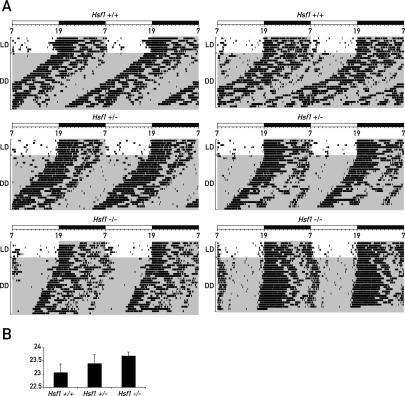Figure 6.
Circadian locomotor activity in mice lacking one (Hsf1+/−) or both (Hsf1−/−) copies of the Hsf1 gene compared with wild-type mice (Hsf1+/+). (A) The voluntary locomotor activity was recorded as wheel-running activity for wild-type Hsf1+/+ mice, heterozygous Hsf1+/− mice, and homozygous Hsf1−/− mice in DD. Typical double-plot actograms obtained for two animals of each genotype are shown. In each actogram, the first few days were recorded under light–dark (LD) conditions (lights on at 7:00; lights off at 19:00). Time spans during which the lights were switched off are marked by gray shading. (B) Period length of wild-type, heterozygous, and homozygous mice in DD. At least 12 animals were analyzed per genotype. The lengths of the free-running periods in hours were 23.05 ± 0.32 (Hsf1+/+), 23.39 ± 0.33 (Hsf1+/−), and 23.68 ± 0.14 (Hsf1−/−). The Student’s t-test was used to examine the data, and the P values for the period length differences compared with Hsf1+/+ mice are 0.008 for Hsf1+/− mice and 2.7 × 10−7 for Hsf1−/− mice.

